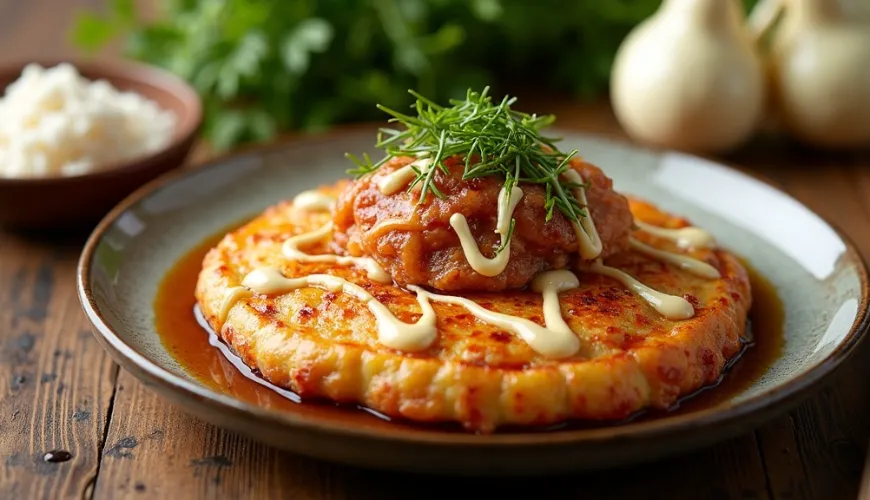
Discover the Secrets of Okonomiyaki and Learn to Cook It Easily

Okonomiyaki - The Japanese Pancake That Tastes a Million Ways
When people think of Japanese cuisine, most often sushi, ramen, or tempura come to mind. However, there's one dish that the Japanese love, found in almost every home and in evening bars known as izakaya – okonomiyaki. This savory pancake, whose name can be loosely translated as "grill what you like," is a symbol of the Japanese approach to cooking: simplicity, freshness, and adaptability.
What is okonomiyaki and why do the Japanese love it so much?
Okonomiyaki is a mix of grated cabbage, batter, and various ingredients prepared on a pan or griddle like a pancake or potato pancake. "Okonomi" means "what you like" or "as you like," and "yaki" means "grilled" or "baked." In other words, it's a dish that everyone can adjust to their taste.
This culinary specialty has its roots in the Kansai region, particularly in Osaka, where its most famous version comes from. In Hiroshima, it's served differently: the layers are stacked on top of each other, often including noodles. In Tokyo and other parts of Japan, you'll find various local variations.
Okonomiyaki has gained popularity not only for its taste but also because it is a cheap, filling, and fun meal that can be made at home or experienced being prepared right in front of you in izakaya-type restaurants. There, a chef often prepares it on a hot griddle while guests enjoy sake or beer.
How to make authentic okonomiyaki at home
Although it may seem complicated at first glance, the recipe for okonomiyaki is surprisingly simple. The basic version contains several commonly available ingredients: flour, eggs, water or broth (preferably dashi), chopped white cabbage, and optional ingredients to taste – such as bacon pieces, shrimp, octopus, kimchi, or cheese.
Besides the ingredients, the combination of sauces and toppings is crucial, giving the dish its typical flavor. Essential is the okonomiyaki sauce, a thick and sweet-sour sauce reminiscent of Worcestershire but milder. Japanese mayonnaise (like Kewpie), dried fish flakes katsuobushi, seaweed aonori, and pickled ginger are also used.
Basic recipe for okonomiyaki (Kansai version):
- In a bowl, mix 150 g of all-purpose flour, 1 egg, and 150 ml of water or dashi broth.
- Add two handfuls of finely chopped cabbage, optionally green onions.
- Add selected ingredients – e.g., shrimp, bacon, or mushrooms.
- Heat a pan with a little oil, pour the mixture onto the pan, and shape it into a circle.
- Fry until golden brown on both sides (about 3–4 minutes each).
- Serve with okonomiyaki sauce, mayonnaise, katsuobushi, and aonori.
This method of cooking also has a social aspect in Japan. In okonomiyaki izakaya type restaurants, guests often prepare their own pancakes right at the table on a built-in griddle. Similar to ordering fondue or grilling on a lava stone in the Czech Republic – the meal becomes an experience.
Okonomiyaki as a cultural phenomenon
Okonomiyaki is not just food – it is part of Japanese everyday life. In Osaka, considered the gastronomic heart of Japan, you find okonomiyaki on every corner. Streets like Dotonbori are lined with restaurants specializing exclusively in this dish.
Yet okonomiyaki is often cooked at home as well – the Japanese love it as a convenient, "home" meal that brings the family together at one table. It's also a dish that allows you to use leftovers from the fridge – like making a "whatever's available" dinner with eggs, onions, and some sausage in the Czech Republic.
In Japanese schools, okonomiyaki is often part of cooking classes, where children can create their own combinations of ingredients. This too reflects its flexibility: there's no single "correct" recipe for okonomiyaki. The possibilities are endless – from vegetarian versions to seafood, to unconventional variations with corn, cheese, or kimchi.
A Japanese proverb says: "Taberu koto wa ikiru koto" – "Eating is living." And okonomiyaki shows how everyday food can be a celebration of life, creativity, and sharing.
Try okonomiyaki differently - vegan and gluten-free variations
However, the classic recipe is not where it has to end. Times are changing, and so are diners' preferences. Many people today seek plant-based versions or gluten-free alternatives. The good news is that okonomiyaki can easily be adapted for various diets.
Instead of regular flour, you can use rice flour or buckwheat flour. The egg can be replaced with a flax or chia "egg," and instead of meat or fish, you can use tempeh, tofu, smoked mushrooms, or marinated jackfruit.
This makes okonomiyaki a perfect meal even for those who prioritize a healthy lifestyle or sustainable diet. And when you add homemade vegan sauce and plant-based mayonnaise, you have a dish that is not only tasty but also planet-friendly.
Where to find okonomiyaki in the Czech Republic?
Opportunities to taste authentic okonomiyaki in Czech restaurants are still limited, but several Japanese bistros and ramen or sushi establishments are starting to include this dish in their menus. Most often, it's found as a specialty in the evening offer in establishments inspired by Japanese izakayas.
One such place in Prague's Letná offers izakaya-style evenings – serving small portions to share, and among sushi and sake, okonomiyaki with pork belly or kimchi appears. Here, you can experience firsthand why this dish is so popular in Japan not only for its flavor but also for the atmosphere it creates.
For those who want to prepare it at home, most ingredients are now available even in Czech e-shops with Japanese groceries or in Asian supermarkets. Fermented products, seaweed, gluten-free flours, or plant-based mayonnaise alternatives are no longer exclusive to specialty stores.
Okonomiyaki proves that great food doesn't have to be complicated or expensive. It only requires a bit of imagination, a few fresh ingredients, and an open mind. And above all – it's a dish that connects. At the table, in the kitchen, and in the heart. Perhaps this Japanese "potato pancake" will teach you that sometimes the best cooking comes from what you love – and what you have on hand.

